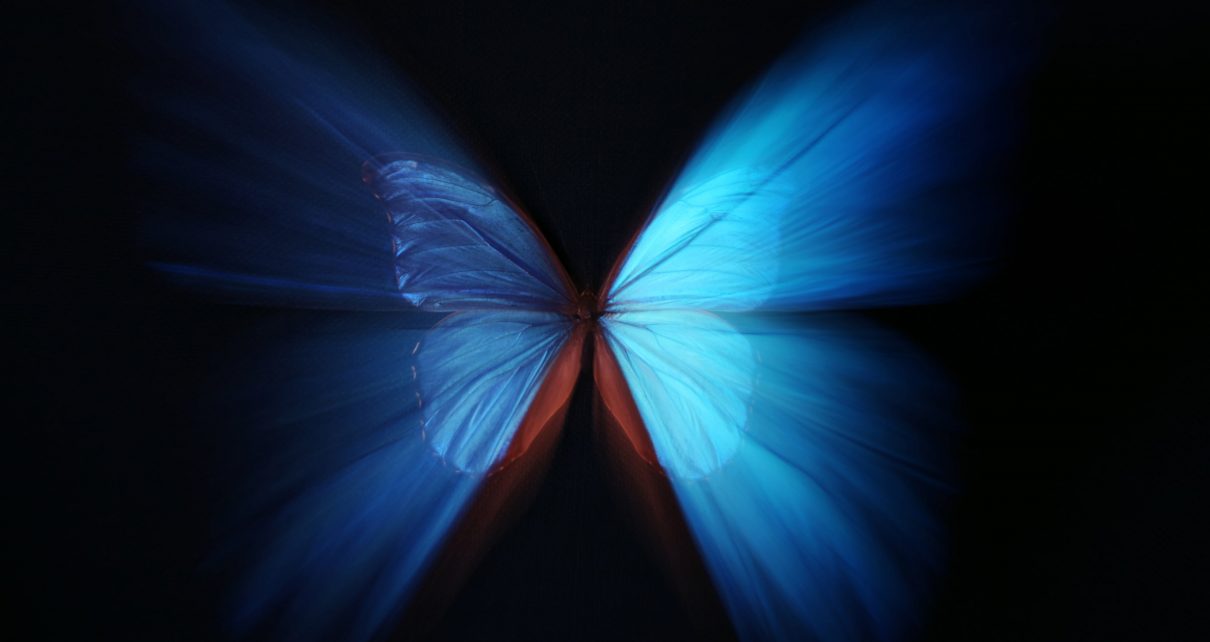Chaos theory says that a tiny, insignificant event or circumstance can have outsized influence in shaping the way a large, complex system evolves into the future. Many people are familiar with this so-called butterfly effect, an idea often traced to science fiction author Ray Bradbury’s 1952 story “A Sound of Thunder.” In that tale, a man who has time-traveled into the deep past to hunt a Tyrannosaurus rex inadvertently crushes a butterfly under his foot. When he returns to the present, he discovers that this seemingly trivial act altered the course of history—and not in a good way.
In the early 1970s, meteorologist and mathematician Edward Norton Lorenz articulated the butterfly effect in science and launched the field of chaos theory. In plain language, this version of the effect says that initial conditions strongly influence the evolution of highly complex systems. In Lorenz’s metaphor, the flapping of a butterfly’s wings in Brazil could ultimately lead a tornado in Texas that wouldn’t have happened otherwise. By implication, if you could go back and alter the past even slightly, a different future would evolve within the system. The future containing your present would vanish.
The butterfly effect is well accepted in our everyday world, where classical physics describes systems above the atomic scale. But in the submicroscopic world where quantum mechanics reigns, different—and very strange—rules apply. Does the butterfly effect still hold true? If not, what happens instead?
As we describe in a peer-reviewed article in Physical Review Letters, we explored this facet of quantum mechanics when we were developing a novel method to protect quantum information. Exploiting the property of quantum entanglement induced by a complex evolution, we wanted to put qubits (quantum bits) into a state where they would be immune to damage. Then they could be retrieved without alteration, even if someone tried to damage or steal the information. That ability would help secure quantum information and provide a method for hiding information, as well.
To do so, we started with a theoretical analysis using the equations of quantum mechanics—good old whiteboard work. Then we ran an experiment on the IBM-Q quantum processor.
For the whiteboard theory phase, we compared the evolution of a complex quantum system to an identically designed system, but with locally changed initial conditions, by measuring and therefore altering one qubit. We expected a result similar to the classical result. That is, as the system evolved over a sufficiently long time, we thought the local variables that described a particular qubit in the once-twin systems eventually would have very different values—in other words, the butterfly effect.
In our thought experiment, we recruited every quantum theorist’s old friends, Alice and Bob, our experimental avatars. The evolution that they considered involved a circuit that evolves in a complex way. The circuit applies many quantum gates randomly to many qubits. The gates perform an operation on the qubits, and each gate represents a step in time, like the tick of a clock.
This is the forward-in-time travel operation in our theoretical “world on a chip.”
Alice prepares one of her qubits in the present time and runs the circuit backwards, emulating travel back in time. In the past, Bob measures the qubit’s polarization, which is the local information stored in Alice’s qubit. Because measurement in the quantum world alters the state of the particle being measured, this measurement changes the polarization, which is the information in this case. Also, by the laws of quantum dynamics, this invasive measurement destroys all of the qubit’s quantum correlations with the rest of the world on a chip. So, we thought this past world was altered in such a way that a return to the previous present—the future of this altered qubit—would change the entire world on a chip.
Next we ran the circuit forward in time to bring the world back to the present time. According to Ray Bradbury’s vision, Bob’s small damage to the state of the qubit should have been quickly magnified during the complex forward-in-time evolution. That would mean that Alice could not recover her information at the end. The squashed butterfly should have drastically altered her information in the present.
But it didn’t.
For our next test of these results, we ran a similar experiment in a simulation on the IBM-Q quantum processor. To simulate time travel, we sent qubits through the computer gates in reverse order. The gates manipulate the qubits and represent time steps as well. Then we damaged information in this simulated past by measuring just one local qubit, while all the other qubits maintained their quantum correlations and remained entangled.
After the damaging measurement, we ran our forward-in-time protocol and then measured the qubit’s state: it had returned to essentially the same state it had been in before backward evolution, plus some small background noise. Because the initial state of the whole system was strongly entangled in quantum correlations, the long complex evolution essentially recovered the information of the perturbed qubit.
To our surprise, we not only disproved the butterfly effect in a quantum system, but we also found a sort of no-butterfly effect, as if the system wants to protect the present.
Being strongly entangled in the quantum sense meant that the system initially had robust quantum correlations among its parts. Entangled qubits share various properties, such as polarization, and in some ways act as one. Even after changing the local information, purely quantum and global correlations across all the entangled qubits put guard rails on the quantum dynamics, guiding them to restore the damaged local variables. The longer and more complex the evolution is, the more quantum correlations it generates, so the better our predictions become, and the more robust the present.
You could say reality in quantum mechanics is self-healing.
Our theory applies to a sufficiently complex quantum evolution in which quantum correlations among the different qubits have time to appear during the backward-in-time evolution. This approach has practical applications, such as testing the quantumness of quantum computers. Where it is uncertain whether a quantum computer is actually using quantum mechanics to get its results—it might still be relying on classical physics—our no-butterfly effect can be used to test it, because our effect is purely quantum mechanical. Another potential application is protecting information, since a random evolution on a quantum circuit can protect a qubit from attack.
Next, we hope to experimentally verify the effect in an actual, physical quantum system in a laboratory (not a quantum computer), probably using ultracold atoms, which behave quantum mechanically. This will allow us to demonstrate the effect under conditions that could be applied to the practical problem of protecting quantum information.
Beyond these practical uses, the no-butterfly effect raises interesting questions about the differences between the quantum realm and the classical-physics world of our everyday experience. Most physicists believe quantum mechanics apply to scale we can observe, anywhere we look, but it often produces the same predictions as classical physics. Physicists are still grappling with how the classical world emerges from the quantum world in our everyday life. To what extent the no-butterfly effect might apply in the macroscopic world of our lives is an open question, as is the degree to which the classical butterfly effect might apply in the quantum world. We hope to answer those questions in future research. Time will tell.
The research described here was supported by the U.S. Department of Energy, Office of Science, Basic Energy Sciences, Materials Sciences and Engineering Division, Condensed Matter Theory Program.



